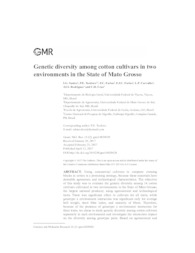Genetic diversity among cotton cultivars in two environments in the State of Mato Grosso.
Genetic diversity among cotton cultivars in two environments in the State of Mato Grosso.
Author(s): SANTOS, I. G.; TEODORO, P. E.; FARIAS, F. C.; FARIAS, F. J. C.; CARVALHO, L. P. de; RODRIGUES, J. I. S.; CRUZ, C. D.
Summary: Using commercial cultivars to compose crossing blocks in cotton is a promising strategy, because these materials have desirable agronomic and technological characteristics. The objective of this study was to evaluate the genetic diversity among 16 cotton cultivars cultivated in two environments in the State of Mato Grosso, the largest national producer, using agronomical and technological traits. There was significant effect to cultivars for all traits, while genotype x environment interaction was significant only for average boll weight, short fiber index, and maturity of fibers. Therefore, because of the presence of genotype x environment interaction for three traits, we chose to study genetic diversity among cotton cultivars separately in each environment and investigate the interaction impact on the diversity among genotype pairs. Based on agronomical and technological performance and genetic diversity among cultivars in both environments, the most promising cross involves FM 910 and LD CV 02. We also observed that lint percentage and average boll weight presented a higher discrimination capacity in both environments.
Publication year: 2017
Types of publication: Journal article
Unit: Embrapa Cotton
Observation
Some of Embrapa's publications are published as ePub files. To read them, use or download one of the following free software options to your computer or mobile device. Android: Google Play Books; IOS: iBooks; Windows and Linux: Calibre.
Access other publications
Access the Agricultural Research Database (BDPA) to consult Embrapa's full library collection and records.
Visit Embrapa Bookstore to purchase books and other publications sold by Embrapa.

